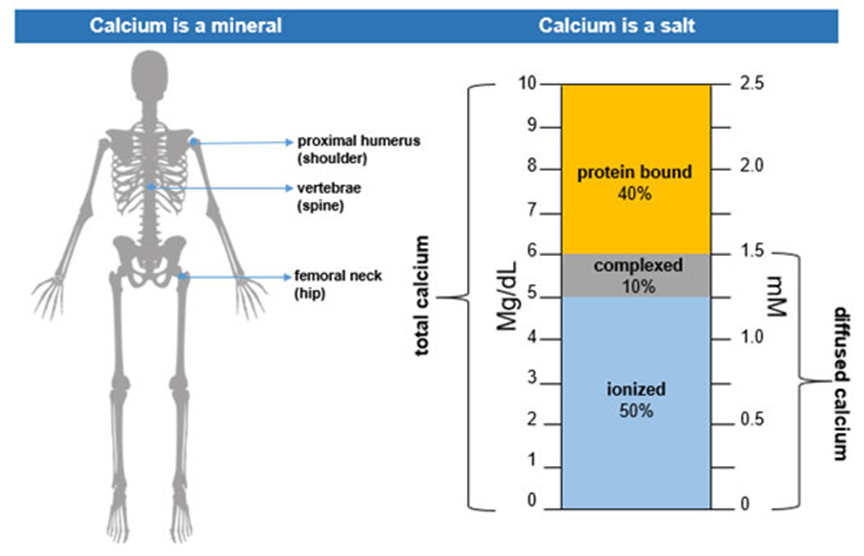What is the normal range of serum calcium in adults?
3.10 to 4.10 mg/dL
5.55 to 6.55 mg/dL
8.50 to 10.50 mg/dL
13.41 to 14.51 mg/dL
The Correct Answer is C
Choice A reason: This is a low value for serum calcium, which indicates hypocalcemia. Hypocalcemia can cause muscle spasms, tetany, seizures, and cardiac arrhythmias.
Choice B reason: This is also a low value for serum calcium, which indicates hypocalcemia. Hypocalcemia can cause muscle spasms, tetany, seizures, and cardiac arrhythmias.
Choice C reason: This is the normal range of serum calcium in adults. Calcium is essential for bone health, muscle contraction, nerve transmission, and blood clotting.
Choice D reason: This is a high value for serum calcium, which indicates hypercalcemia. Hypercalcemia can cause nausea, vomiting, constipation, confusion, lethargy, and kidney stones.

Nursing Test Bank
Naxlex Comprehensive Predictor Exams
Related Questions
Correct Answer is C
Explanation
Choice A reason: This is incorrect because low HCO3- and high PaCO2 are signs of metabolic acidosis, not alkalosis. Metabolic acidosis is a condition where the blood pH is lower than the normal range of 7.35 to 7.45, due to an excess of acids or a loss of bases in the body.
Choice B reason: This is incorrect because low PaCO2 and low HCO3- are signs of respiratory acidosis, not alkalosis. Respiratory acidosis is a condition where the blood pH is lower than the normal range of 7.35 to 7.45, due to impaired gas exchange or hypoventilation, which causes carbon dioxide to accumulate in the blood.
Choice C reason: This is correct because low PaCO2 and high HCO3- are signs of alkalosis. Alkalosis is a condition where the blood pH is higher than the normal range of 7.35 to 7.45, due to a loss of acids or an excess of bases in the body. There are two types of alkalosis: respiratory and metabolic. Respiratory alkalosis is caused by hyperventilation, which lowers the PaCO2 in the blood. Metabolic alkalosis is caused by vomiting, diuretics, or excessive intake of antacids, which raises the HCO3- in the blood.
Choice D reason: This is incorrect because high PaCO2 and high HCO3- are signs of compensation, not alkalosis. Compensation is a process where the body tries to restore the normal pH by adjusting the levels of PaCO2 and HCO3- in the opposite direction of the primary disorder. For example, if the patient has metabolic alkalosis, the respiratory system will try to compensate by retaining carbon dioxide and lowering the PaCO2. If the patient has respiratory alkalosis, the renal system will try to compensate by excreting bicarbonate and lowering the HCO3-.
Correct Answer is A
Explanation
Choice A reason: This is correct because respiratory acidosis is a condition where the blood pH is lower than the normal range of 7.35 to 7.45, due to impaired gas exchange or hypoventilation, which causes carbon dioxide to accumulate in the blood. COPD is a chronic lung disease that obstructs the airways and reduces the oxygen intake and carbon dioxide output. This leads to respiratory acidosis in the patient.
Choice B reason: This is incorrect because respiratory alkalosis is a condition where the blood pH is higher than the normal range of 7.35 to 7.45, due to hyperventilation, which lowers the carbon dioxide in the blood. COPD does not cause hyperventilation, but rather hypoventilation.
Choice C reason: This is incorrect because metabolic alkalosis is a condition where the blood pH is higher than the normal range of 7.35 to 7.45, due to a loss of acids or an excess of bases in the body. COPD does not affect the metabolic system directly, but rather the respiratory system.
Choice D reason: This is incorrect because metabolic acidosis is a condition where the blood pH is lower than the normal range of 7.35 to 7.45, due to an excess of acids or a loss of bases in the body. COPD does not affect the metabolic system directly, but rather the respiratory system.
Whether you are a student looking to ace your exams or a practicing nurse seeking to enhance your expertise , our nursing education contents will empower you with the confidence and competence to make a difference in the lives of patients and become a respected leader in the healthcare field.
Visit Naxlex, invest in your future and unlock endless possibilities with our unparalleled nursing education contents today
Report Wrong Answer on the Current Question
Do you disagree with the answer? If yes, what is your expected answer? Explain.
Kindly be descriptive with the issue you are facing.
